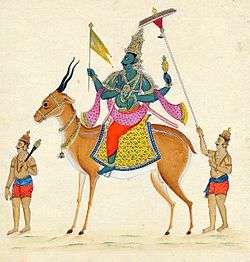Vayu
| Vayu | |
|---|---|
| [1] | |
 Vayu, on his mount, the gazelle symbolizing swiftness | |
| Devanagari | वायु |
| Sanskrit transliteration | Vāyu |
| Affiliation | Deva, Guardians of the directions |
| Abode | Gandhavati |
| Mantra | Om Vayuve namaha |
| Weapon | Flag |
| Consort | Swasti, Bharati, |
| Mount | Gazelle |
Vāyu (Sanskrit, Sanskrit pronunciation: [ʋaːyu]) is a primary Hindu deity, the lord of the winds, the father of Bhima and the spiritual father of Hanuman. He is also known as Vāta, Pavana ("the Purifier"),[2] and sometimes Prāṇa ("the breath").
Connotations
The word for air (vāyu) or wind (pavana) is one of the classical elements in Hinduism. The Sanskrit word 'Vāta' literally means "blown", 'Vāyu' "blower", and Prāna "breathing" (viz. the breath of life, cf. the *an- in 'animate'). Hence, the primary referent of the word is the "deity of Life", who is sometimes for clarity referred to as "Mukhya-Vāyu" (the chief Vāyu) or "Mukhya Prāna" (the chief of Life).
Sometimes the word "vāyu," which is more generally used in the sense of the physical air or wind, is used as a synonym for "prāna".[3] Vāta, an additional name for Vāyu, is the root of the Sanskrit and Hindi term for "atmosphere", vātāvaran.[4]
Pavan is also a fairly common Hindu name. Pavana played an important role in Anjana's begetting Hanuman as her child so Hanuman is also called Pavanaputra "son of Pavana" and Vāyuputra.
In the Mahabharata, Bhima was the son and an incarnation of Vāyu and played a major role in the Kurukshetra War. He utilised his huge power and skill with the mace for supporting Dharma.
Hindu texts and philosophy
| Classical elements |
|---|
|
Stoicheion (στοιχεῖον) |
|
Tattva – Mahābhūta, Panchikarana |
|
Wŭ Xíng (五行) |
|
Godai (五大) |
|
Bön |
|
Alchemy |
In the hymns, Vayu is "described as having 'exceptional beauty' and moving noisily in his shining coach, driven by two or forty-nine or one-thousand white and purple horses. A white banner is his main attribute."[2] Like the other atmospheric deities, he is a "fighter and destroyer", "powerful and heroic."[5]
In the Upanishads, there are numerous statements and illustrations of the greatness of Vāyu. The Brihadaranyaka Upanishad states that the gods who control bodily functions once engaged in a contest to determine who among them is the greatest. When a deity such as that of vision would leave a man's body, that man would continue to live, albeit as a blind man and having regained the lost faculty once the errant deity returned to his post. One by one the deities all took their turns leaving the body, but the man continued to live on, though successively impaired in various ways. Finally, when Mukhya Prāna started to leave the body, all the other deities started to be inexorably pulled off their posts by force, "just as a powerful horse yanks off pegs in the ground to which he is bound." This caused the other deities to realize that they can function only when empowered by Vayu, and can be overpowered by him easily. In another episode, Vāyu is said to be the only deity not afflicted by demons of sin who were on the attack. The Chandogya Upanishad states that one cannot know Brahman except by knowing Vāyu as the udgitha (the mantric syllable om).
Mukhya-Vāyu also incarnated as Madhvacharya to teach worthy souls to worship the Supreme God Vishnu.
Buddhism
In the Buddhism of the Far East, Vayu is one of the twelve Devas, as guardian deities, who are found in or around Buddhist shrines (Jūni-ten, 十二天).[6] In Japan, he has been called "Fu-ten".[7] He joins these other eleven Devas of Buddhism, found in Japan and other parts of southeast Asia: Indra (Taishaku-ten), Agni (Ka-ten), Yama (Emma-ten), Nirrti (Rasetsu-ten), Vayu (Fu-ten), Ishana (Ishana-ten), Kubera (Tamon-ten), Varuna (Sui-ten) Brahma (Bon-ten), Prithvi (Chi-ten), Surya (Nit-ten), Chandra (Gat-ten).[8][7][9]
Filmography
| Year | Name | Channel | Country | Played by |
|---|---|---|---|---|
| 2015 | Sankatmochan Mahabali Hanuman | Sony Entertainment Television | India | Manish Bishla |
See also
- List of wind deities
- Vayu-Vata - in his Zoroastrian context
- Vayu Purana
References
- ↑ The Book of Hindu Imagery: Gods, Manifestations and Their Meaning By Eva Rudy Jansen p. 68
- 1 2 Eva Rudy Jansen, Tony Langham (1993), The book of Hindu imagery: The Gods and their Symbols, Binkey Kok Publications, ISBN 90-74597-07-6,
God of the wind ... also known as Vata or Pavan ... exceptional beauty ... moves on noisily in his shining coach ... white banner ...
- ↑ Raju, P.T. (1954), "The concept of the spiritual in Indian thought", Philosophy East and West 4 (3): 195–213, doi:10.2307/1397554, JSTOR 1397554.
- ↑ Vijaya Ghose, Jaya Ramanathan, Renuka N. Khandekar (1992), Tirtha, the treasury of Indian expressions, CMC Limited, ISBN 978-81-900267-0-3,
... God of the winds ... Another name for Vayu is Vata (hence the present Hindi term for 'atmosphere, 'vatavaran). Also known as Pavana (the purifier), Vayu is lauded in both the ...
- ↑ Sukumari Bhattacharji (1984), Literature in the Vedic age, K.P. Bagchi,
... The other atmospheric gods are his associates: Vayu-Vatah, Parjanya, the Rudras and the Maruts. All of them are fighters and destroyers, they are powerful and heroic ...
- ↑ Twelve Heavenly Deities (Devas) Nara National Museum, Japan
- 1 2 S Biswas (2000), Art of Japan, Northern, ISBN 978-8172112691, page 184
- ↑ Willem Frederik Stutterheim et al (1995), Rāma-legends and Rāma-reliefs in Indonesia, ISBN 978-8170172512, pages xiv-xvi
- ↑ Adrian Snodgrass (2007), The Symbolism of the Stupa, Motilal Banarsidass, ISBN 978-8120807815, pages 120-124, 298-300
| |||||||||||||||||||||
